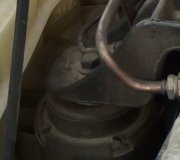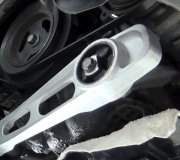The solid engine when shifting gears is a clue. If the engine doesn't rock, it is not being held up by the rubber isolators. The best suspect is the rubber is deteriorated and the two metal parts of a mount are contacting each other. That will shake the entire car and be quite miserable. One potential clue to a collapsed engine mount can be seen where the radiator fan blade is not centered in the shroud. If there's a big gap on top, or the blade is off-center within the shroud, recheck the engine mounts.
The transmission mount is usually a "captive" design where the rubber isolator can't fall out, but if it is deteriorated, it can let the tail housing of the transmission sag. Sometimes you can lift that tail housing by hand and see the movement. Sometimes you can see the mount just doesn't look right. With a sagged tail housing, look for the drive shaft laying on an exhaust pipe or parking brake cable and transmitting engine vibration through those into the body. Even the shifter linkage, from the days before they went to a cable, have pivoting shafts that sit inside rubber or plastic bushings. Look for one of those that has cracked away, or a shaft is rubbing on the metal bracket. Rust can cause that too even when the engine mounts are fine.
Also look for a broken exhaust hanger, especially one that has a rubber isolator between the two metal parts. A broken hanger that is cobbled with wound-up wire tends to not result in this type of vibration, but a metal hanger sitting on the other half of the hanger will transmit normal engine vibration into the body where you will definitely feel it.
A less-common cause of vibration is sagged springs. Those can be expected due to the car's age. Every repair shop has a small book that lists every car model and year, where to take the measurements, and what they should be. Besides all the other problems sagged springs cause, that will change the angle of the drive shaft where it exits the transmission and where it attaches to the rear axle. That reduced angle is a common source of vibration when the car is moving, especially at higher speeds. When the vibration occurs when standing still, like you described, look instead for something the drive shaft is rubbing on. That's almost always a parking brake cable that runs right over the drive shaft, just behind the transmission. That has to be up high enough to clear the drive shaft when the car is heavily-loaded or goes over bumps in the road, so when you find this, you'll find a "witness mark" in the form of a rub mark around the drive shaft, and the cause is often a rusted attaching hanger for the cable. You'd find a clue by getting the vibration to occur, then observing it goes away when lifting on the rear of the car a little.
I've also had cars that had a metal strap welded to the end of the tail pipe to form a hanger. It has a 90 degree bend in it, then the strap slides through a rubber isolator that is held in the bracket that's bolted to the body. On one occasion the tail pipe was loose in the muffler, and it slide back, then that strap came out of the isolator and the pipe dropped down onto the rear axle housing. That caused more high-pitched buzzing noise and less vibration. On another car, that rubber isolator squirted out, then the strap fell down the 1/2" and sat on the metal bracket. That one didn't make any noise, but there was a horrendous vibration felt only when idling.
Everything up to this point refers to a normal engine vibration that you aren't supposed to be able to feel. Whatever is wrong is letting those vibrations transmit into the passenger compartment. Also consider the defect could be causing an abnormal vibration that at times you are unable to feel. The best example I can think of, although a poor one, would be a single-cylinder misfire due to a fouled spark plug or bad plug wire. You can feel that because the rotational speed of the crankshaft slows down when that misfire occurs. That becomes much harder to feel when you raise engine speed. This would be a case of feeling the vibration at idle is the normal condition, as far as diagnosing it goes, and raising engine speed is what you'd want to avoid during the diagnosis step since it makes the problem go away. In the first half of the story, we're diagnosing a normal vibration that you aren't supposed to feel. In this second part, there's an abnormal vibration that can't always be felt. For those, here's a link to an article that refers to those things:
https://www.2carpros.com/articles/vibration-noise
Friday, March 22nd, 2019 AT 11:24 PM



